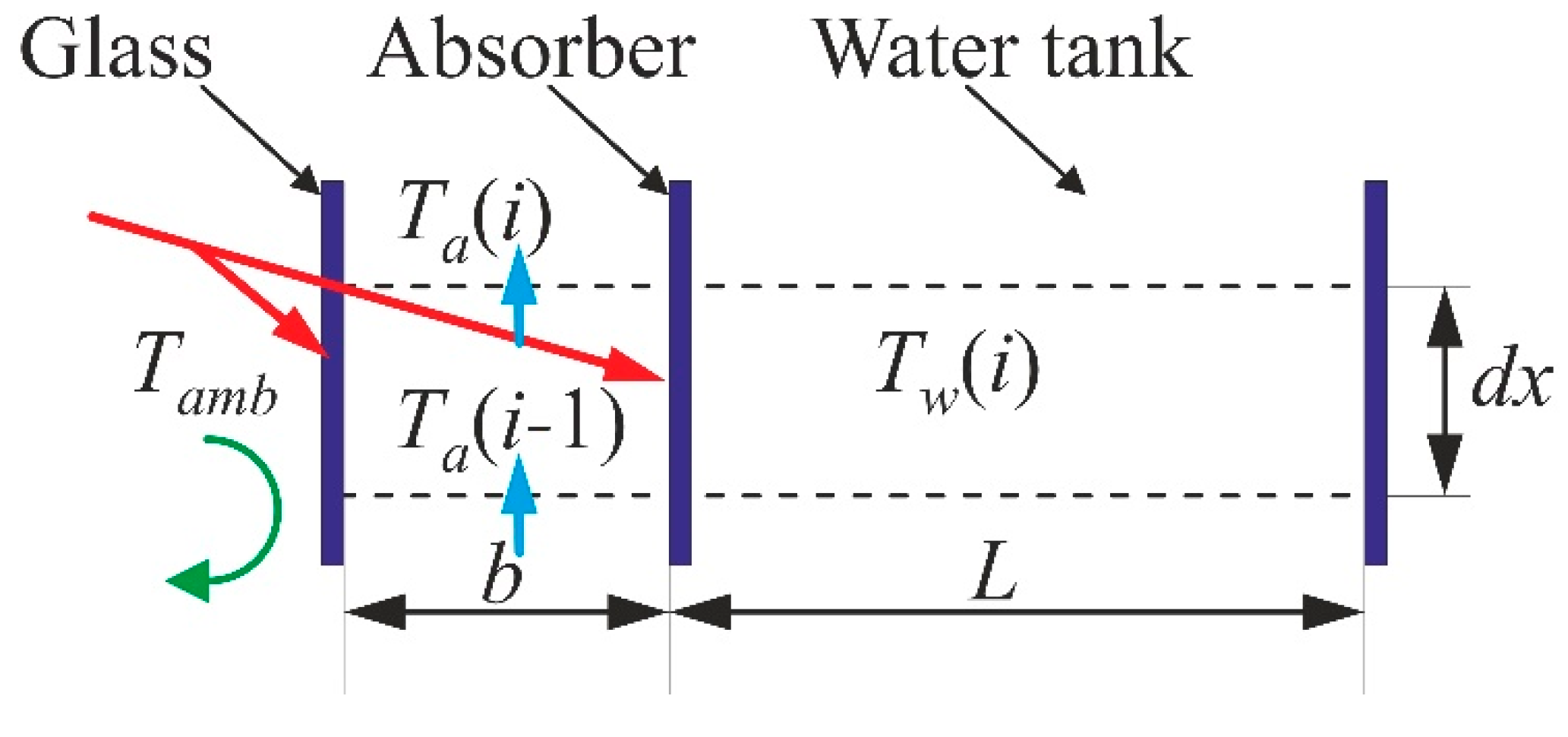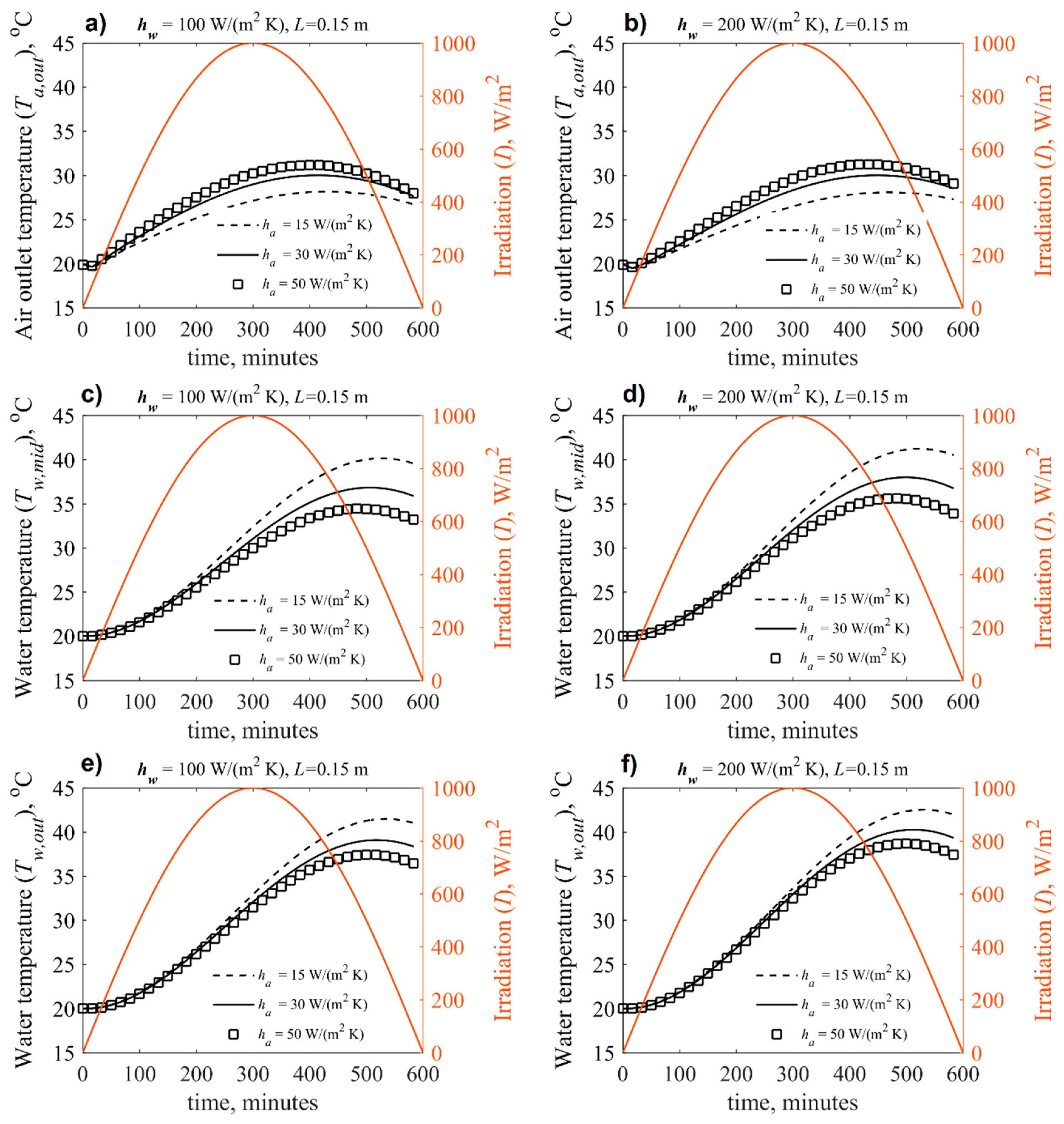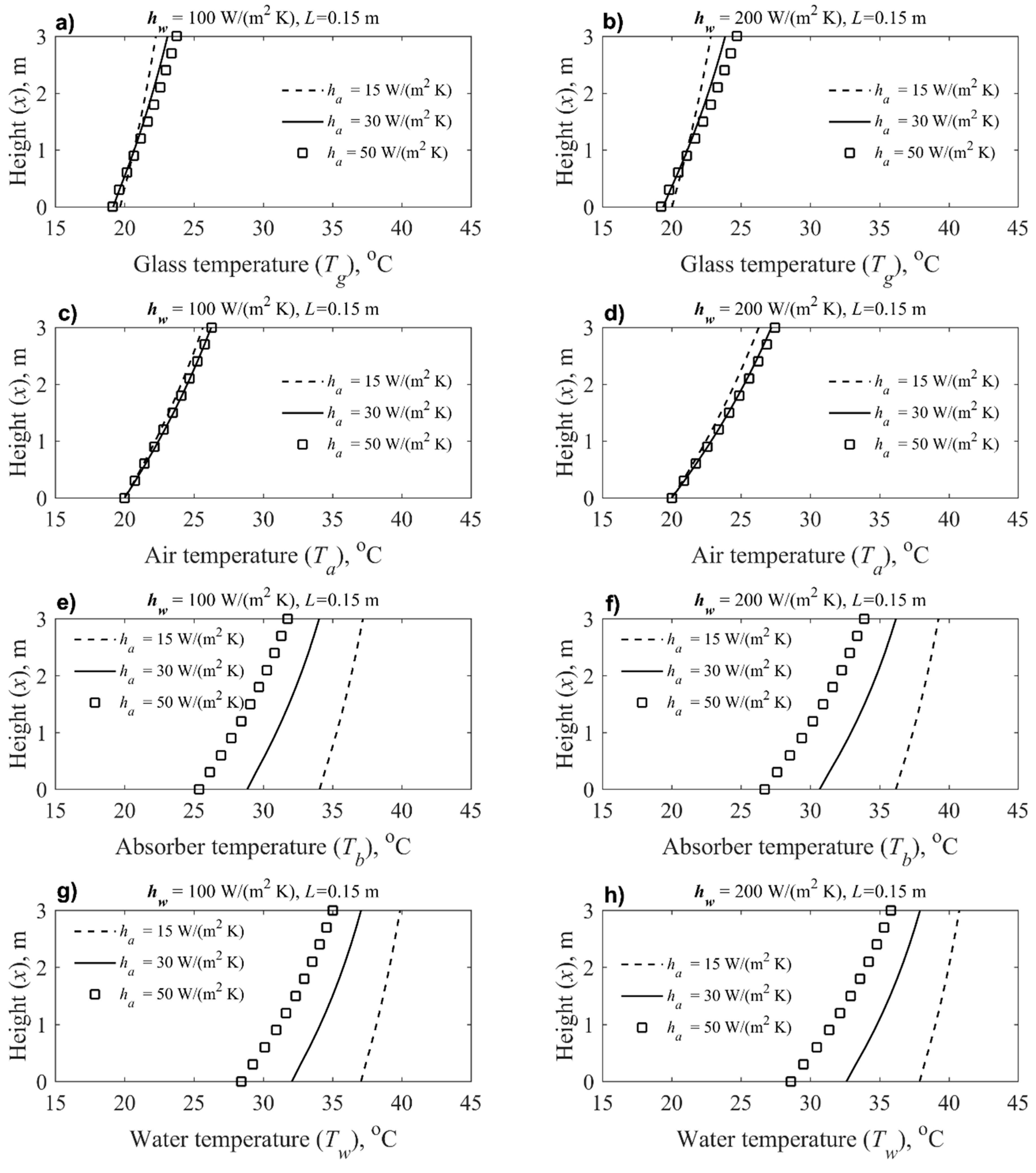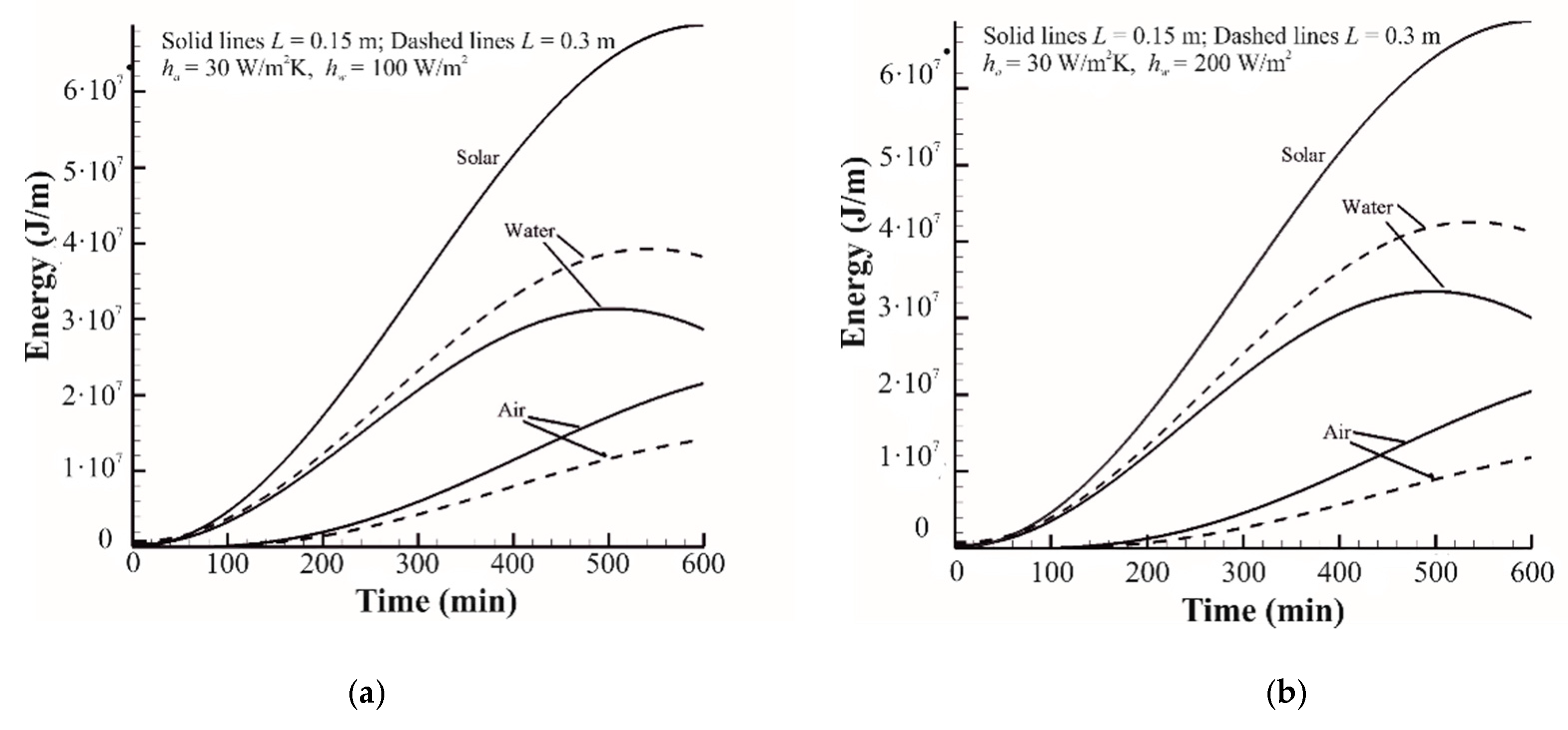Trombe Wall Utilization for Cold and Hot Climate Conditions
Abstract
:1. Introduction
2. The Modified Trombe Wall
3. Comparison with the Conventional Trombe Walls
- The specific heat and density of water are 4.186 kJ/(kg·K) and 1000 kg/m3, respectively. Hence, the heat capacity of water per unit volume is 4186 kJ/(m3·K). However, the specific heat and density of the concrete is about 0.880 kJ/(kg·K) and 2300 kg/m3, respectively. Hence, the heat capacity of the concrete per unit volume is about 2024 kJ/(m3·K). Therefore, for the same volume, the water tank can carry more than double the amount of thermal energy compared with concrete for the same temperature rise. The building brick has almost the same heating capacity as that of the concrete [37]. However, the water tank may need metal support, which adds extra weight.
- Heat losses in any thermal system are proportional to the temperature difference between the system and ambient temperature. Since the heat capacity of water is higher than the concrete, as mentioned above, the heat losses by convection and radiation from the water tank should be less than the concrete slab for the same amount of energy received from the sun.
- The charging and discharging processes from the proposed system occur by convection. While the charging and discharging processes from the concrete slab are done by the thermal diffusion process, it is a fact that convection heat transfer is a more efficient mechanism of heat transfer compared to the diffusion process.
- The main problem of conventional Trombe wall in the summer season is excessive heat, which overheats the building. However, in the proposed system, the water in the tank can be circulated. Hence, in the summer season, excess heat can be extracted out of the building.
- Furthermore, water is 2.3 times lighter than concrete (density ratio). Hence, the structure needed to support the water tank should be simpler. The metal cover of a water tank with a thickness of 6 mm can be used. Thus, the overall costs of the system may not be significant.
4. Thermal Modelling
5. Results
6. Energy and Efficiency
7. Conclusions
Author Contributions
Funding
Conflicts of Interest
References
- Llovera, J.; Potau, X.; Medrano, M.; Cabeza, L.F. Desgin and performance of energy-efficient solar residential house in Andorra. Appl. Energy 2011, 88, 1343–1353. [Google Scholar] [CrossRef]
- Trombe, F.; Robert, J.F.; Cabanat, M.; Sesolis, B. Some performance characteristics of the CNRS solar house collectors. In Proceedings of the Passive Solar Heating and Cooling Conference and Workshop, Los Alamos Scientific Laboratory Report LA-6637-C, Albuquerque, NM, USA, 18–19 May 1976; pp. 201–202. [Google Scholar]
- Akbarzadeh, A.; Charters, W.W.S.; Lesslie, D.A. Thermocirucultation Characteristics of a Trombe Wall Passive Test Cell. Sol. Energy 1982, 28, 461–468. [Google Scholar] [CrossRef]
- Ben Yedder, R.; Bilgen, E. Natural convection and conduction in Trombe wall systems. Int. J. Heat Mass Transf. 1991, 34, 1237–1248. [Google Scholar] [CrossRef]
- Tunc, M.; Uysal, M. Passive solar heating of buildings using a fluidized bed plus Trombe wall system. Appl. Energy 1991, 38, 199–213. [Google Scholar] [CrossRef]
- Chen, W.; Liu, W. Numerical analysis of heat transfer in a composite wall solar-collector system with a porous absorber. Appl. Energy 2004, 78, 137–149. [Google Scholar] [CrossRef]
- Jaber, S.; Ajib, S. Optimum design of Trombe wall system in Mediterranean region. Sol. Energy 2011, 85, 1891–1898. [Google Scholar] [CrossRef]
- Duffie, J.; Beckman, W. Solar Engineering of Thermal Processes; John Wiley and Sons, Inc.: Hoboken, NJ, USA, 2006. [Google Scholar]
- Sun, W.; Ji, J.; Luo, C.; He, W. Performance of PV-Trombe wall in winter correlated with south façade design. Appl. Energy 2011, 88, 224–231. [Google Scholar] [CrossRef]
- Saadatian, O.; Sopian, K.; Lim, C.H.; Asim, N.; Sulaiman, M.Y. Trombe walls: A review of opportunities and challenges in research and development. Renew. Sustain. Energy Rev. 2012, 16, 6340–6351. [Google Scholar] [CrossRef]
- Bajc, T.; Todorovic, M.N.; Svorcan, J. CFD analyses for passive house with Trombe wall and impact to energy demand. Energy Build. 2015, 98, 39–44. [Google Scholar] [CrossRef]
- He, W.; Hu, Z.; Luo, B.; Hong, X.; Sun, W.; Ji, J. The thermal behavior of Trombe wall system with Venetian blind: An experimental and numerical study. Energy Build. 2015, 104, 395–404. [Google Scholar] [CrossRef]
- He, W.; Hong, X.; Wu, X.; Pei, G.; Hu, Z.; Tang, W.; Shen, Z.; Ji, J. Thermal and hydraulic analysis on a novel Trombe wall with Venetian blind structure. Energy Build. 2016, 123, 50–58. [Google Scholar] [CrossRef]
- Hernandez-Lopez, I.; Xaman, J.; Chavez, Y.; Henandez-Perez, I.; Alvarado-Juarez, R. Thermal energy storage and losses in a room-Trombe wall system located in Mexico. Energy 2016, 109, 512–524. [Google Scholar] [CrossRef]
- Taffesse, F.; Verma, A.; Singh, S.; Tiwari, G.N. Periodic modeling of semi-transparent photovoltaic thermal-Trombe wall (SPVT-TW). Sol. Energy 2016, 135, 265–273. [Google Scholar] [CrossRef]
- Duan, S.; Jing, C.; Zhao, Z. Energy and exergy analysis of different Trombe walls. Energy Build. 2016, 126, 517–523. [Google Scholar] [CrossRef]
- Jovana, J.; Sun, X.; Stevovic, S.; Chen, J. Energy-efficiency gain by combination of PV modules and Trombe wall in the low-energy building design. Energy Build. 2017, 152, 568–576. [Google Scholar]
- Hu, Z.; He, W.; Ji, J.; Hu, D.; Lv, S.; Chen, H.; Shen, Z. Comparative study on the annual performance of three types of building integrated photovoltaic (BIPV) Trombe wall system. Appl. Energy 2017, 194, 81–93. [Google Scholar] [CrossRef]
- Hu, Z.; He, W.; Hu, D.; Lv, S.; Wang, L.; Ji, J.; Chen, H.; Ma, J. Design, construction and performance testing of a PV blind-integrated Trombe wall module. Appl. Energy 2017, 203, 643–656. [Google Scholar] [CrossRef]
- Yu, B.; He, W.; Li, N.; Wang, L.; Cai, J.; Chen, H.; Ji, J.; Xu, G. Experimental and numerical performance analysis of a TC-Trombe wall. Appl. Energy 2017, 206, 70–82. [Google Scholar] [CrossRef]
- Rabani, M.; Kalantar, V.; Rabani, M. Heat transfer analysis of a Trombe wall with a projecting channel design. Energy 2017, 134, 943–950. [Google Scholar] [CrossRef]
- Luo, Y.; Zhang, L.; Wu, J.; Liu, Z.; Wu, Z.; He, W. Dynamical simulation of building integrated photovoltaic thermoelectric wall system: Balancing calculation speed and accuracy. Appl. Energy 2017, 204, 887–897. [Google Scholar] [CrossRef]
- Jayathissa, P.; Luzzatto, M.; Schmidli, J.; Hofer, J.; Nagy, Z.; Schlueter, A. Optimising building net energy demand with dynamic BIPV shading. Appl. Energy 2017, 202, 726–735. [Google Scholar] [CrossRef]
- Hong, S.; Choi, A.-S.; Sung, M. Development and verification of a slat control method for a bi-directional PV blind. Appl. Energy 2017, 206, 1321–1333. [Google Scholar] [CrossRef]
- Corasaniti, S.; Manni, L.; Russo, F.; Gori, F. Numerical simulation of modified Trombe-Michel Walls with exergy and energy analysis. Int. Commun. Heat Mass Transf. 2017, 88, 269–276. [Google Scholar] [CrossRef]
- Leang, E.; Tittelein, P.; Zalewski, L.; Lassue, S. Numerical study of a composite Trombe solar wall integrating microencapsulated PCM. Energy Procedia 2017, 122, 1009–1014. [Google Scholar] [CrossRef]
- Hu, Z.; He Ji, J.; Zhang, S. A review on the application of Trombe wall system in buildings. Renew. Sustain. Energy Rev. 2017, 70, 976–987. [Google Scholar] [CrossRef]
- Ma, Q.; Fukuda, H.; Lee, M.; Kobatake, T.; Kuma, Y.; Ozaki, A. Study on the utilization of heat in the mechanically ventilated Trombe wall in a house with a central air conditioning and air circulation system. Appl. Energy 2018, 222, 861–871. [Google Scholar] [CrossRef]
- Long, J.; Yongga, A.; Sun, H. Thermal insulation performance of a Trombe wall combined with collector and reflection layer in hot summer and cold winter zone. Energy Build. 2018, 171, 144–154. [Google Scholar] [CrossRef]
- Souayfane, F.; Biwole, P.H.; Fardoun, F. Thermal behavior of a translucent superinsulated latent heat energy storage wall in summertime. Appl. Energy 2018, 217, 390–408. [Google Scholar] [CrossRef]
- Yu, B.; Jiang, Q.; He, W.; Hu, Z.; Chen, H.; Ji, J.; Xu, G. The performance analysis of a novel TC-Trombe wall system in heating seasons. Energy Convers. Manag. 2018, 164, 242–261. [Google Scholar] [CrossRef]
- Bernardo, L.R.; Davidsson, H.; Karlsson, B. Retrofitting Domestic Hot Water Heaters for Solar Water Heating Systems in Single-Family Houses in a Cold Climate: A Theoretical Analysis. Energies 2012, 5, 4110–4131. [Google Scholar] [CrossRef] [Green Version]
- Fu, X.; Qian, X.; Wang, L. Energy Efficiency for Airtightness and Exterior Wall Insulation of Passive Houses in Hot Summer and Cold Winter Zone of China. Sustainability 2017, 9, 1097. [Google Scholar]
- Haggag, M.; Hassan, A.; Qadir, G. Energy and Economic Performance of Plant-Shaded Building Façade in Hot Arid Climate. Sustainability 2017, 9, 2026. [Google Scholar] [CrossRef]
- Huang, L.; Zheng, R. Energy and Economic Performance of Solar Cooling Systems in the Hot-Summer and Cold-Winter Zone. Buildings 2018, 8, 37. [Google Scholar] [CrossRef]
- Lanahan, M.; Tabares-Velasco, P.C. Seasonal Thermal-Energy Storage: A Critical Review on BTES Systems, Modeling, and System Design for Higher System Efficiency. Energies 2017, 10, 743. [Google Scholar] [CrossRef]
- Incropera, F.P.; DeWitt, D.P. Fundamentals of Heat and Mass Transfer, 5th ed.; John Wiley & Sons: New York, NY, USA, 2002. [Google Scholar]











| Parameters | Water Properties | Air Properties | Geometry |
|---|---|---|---|
| ham = 10 W/(m2·K) ha = 30 and 50 W/(m2·K) hw = 100 W/(m2·K), and 200 W/(m2·K) αp = 0.94 αg = 0.02 τg = 0.97 Tamb = 15 °C Troom = 20 °C | ρw = 1000 kg/m3 cw = 4186 J/(kg·K) | ρa = 1.0 kg/m3 ca = 1000 J/(kg·K) | b = 0.1 m L = 0.15 and 0.3 m H = 3.0 m |
© 2019 by the authors. Licensee MDPI, Basel, Switzerland. This article is an open access article distributed under the terms and conditions of the Creative Commons Attribution (CC BY) license (http://creativecommons.org/licenses/by/4.0/).
Share and Cite
Mohamad, A.; Taler, J.; Ocłoń, P. Trombe Wall Utilization for Cold and Hot Climate Conditions. Energies 2019, 12, 285. https://doi.org/10.3390/en12020285
Mohamad A, Taler J, Ocłoń P. Trombe Wall Utilization for Cold and Hot Climate Conditions. Energies. 2019; 12(2):285. https://doi.org/10.3390/en12020285
Chicago/Turabian StyleMohamad, Abdulmajeed, Jan Taler, and Paweł Ocłoń. 2019. "Trombe Wall Utilization for Cold and Hot Climate Conditions" Energies 12, no. 2: 285. https://doi.org/10.3390/en12020285





